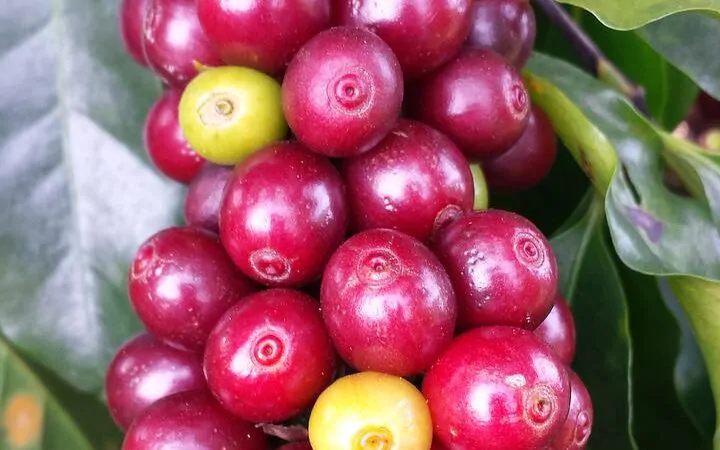It is one of the most sought-after variants which comprises more than half of the coffee beans produced worldwide, so what are Caturra coffee beans?

When I first happened upon the Caturra coffee beans, I was reminded of one of my favorite TV shows when I was a kid; X-Men. Not because of Beast (who loves coffee, by the way), but because this coffee bean variant is a mutant. How awesome is that?
If you trace its origins, Caturra is a natural mutation of Bourbon. This Arabica coffee bean cultivar originated in Yemen and was first introduced on the island of Bourbon, now known as Reunion, by the French in the 18th century. Think of Caturra as Arabica’s grandchild so you won’t get confused.
Caturra’s Discovery And Expansion

The bourbon coffee bean became widespread as it traversed from Reunion to South Africa and South America. The Caturra was first discovered in Brazil during the 1910s when farmers saw a smaller-than-usual plant that sprouted much more coffee cherries.
This prompted the agronomic institute in Campinas, Brazil, to conduct a mass selection of seeds that have superior features that are ideal for cultivation.
Global commercialization started around the 1970s, most prominently in Central and South American countries such as Guatemala, Honduras, and Columbia, among others. Due to its undemanding space requirement, high-yielding feature, and superior fruit quality, it became one of the most economically important coffees in Central and South America and served as the benchmark against their new cultivars.
The Challenge Of Growing A Caturra
One challenge that producers have found is that Caturra is a high-maintenance plant as it is very susceptible to fungus and various plant diseases. The most notorious one is the coffee rust that infects the plant’s leaves and festers, affecting the taste quality and the yield quantity of the Caturra or, worse, will kill the plant itself.
Farmers were able to work around this by proper farming maintenance, and mass selection to increase the area where it is farmed. They also cultivated a new coffee bean family called Catimor – a cross-breed between the coffee rust-resistant Hybrido de Timor and Caturra. This crossbreed produced varieties such as Catisic, Costa Rica 95, and Lempira to name a few.
You might also be interested in our Brazilian vs. Colombian coffee guide.
Caturra Coffee Bean Flavor Profile And Varieties

Caturra might arguably be one of the most complex in terms of taste. The varieties share a common flavor foundation – mild with a hint of fruity sweet and sour aftertaste. But since these varieties are cultivated in different parts of the world, each with its distinct weather conditions and elevations, the complementary flavors differ.
For instance, in the southeast Asian nation of Thailand, their Caturra varieties, Kafae Doi Chaang are sweeter with a definite flowery and cherry-like flavor and aroma.
Caturras in most Latin American countries tend to be more nutty and citrusy, with some containing hints of chocolate and honey. A noteworthy coffee bean in Columbia called Los Rosales contains notes of stone fruit, caramel, orange, and almond. No wonder their creator won Roast Magazine’s Roaster of the Year.
Another interesting Caturra variant is the Maui Yellow Caturra which can be found in Hawaii. These are grown from the Maui island’s volcanic soil and produce a yellow color instead of the usual red when ripe. It is marginally less acidic, has a subtle spicy chocolate kick, and a somewhat malty texture and wheat-like taste.
The roasting process also plays a role in enhancing the acidity or the flavor of this bourbon varietal. If you are aiming for the former, you can do a light roast. Otherwise, opt for the medium to dark roast to preserve most of its fruity, chocolatey, and or nutty sweet flavor.
You might also be interested in learning about Maragogype coffee.
FAQs On Caturra Coffee Beans
What Is The Difference Between Varietal And Cultivar?
We call a type of coffee bean a varietal if it mutated naturally, much like the Caturra. These mutations can happen due to several factors, ranging from a random genetic code change to something as predictable as weather changes.
Cultivars, on the other hand, are man-made mutations achieved through cross-breeding different varieties of coffee plants or controlled seed production.
There are four main coffee species in the world; one is the Arabica. Under it is a variety called the Bourbon, a cultivar. This cultivar then had a natural mutation which gave us the Caturra, so the latter is considered a varietal.
Is Caturra Coffee Healthy?
Caturra coffee still retains the health benefits that a cup of Joe can provide. Still, it is somewhat acidic, so you might want to supervise your intake.
How Much Caffeine Does A Caturra Coffee Have?
It has lower caffeine content compared to its mother breed. Arabica coffee beans contain about 12 mg of caffeine per gram, while the Caturra has around nine mg per gram.
